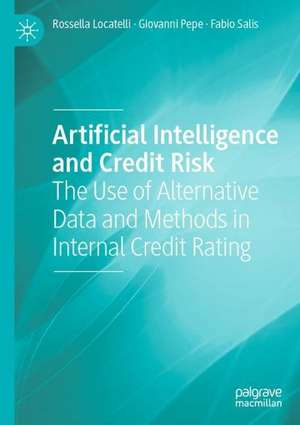Artificial Intelligence and Credit Risk: The Use of Alternative Data and Methods in Internal Credit Rating
Autor Rossella Locatelli, Giovanni Pepe, Fabio Salisen Limba Engleză Hardback – 14 sep 2022
Preț: 318.90 lei
Nou
Puncte Express: 478
Preț estimativ în valută:
61.03€ • 63.33$ • 51.01£
61.03€ • 63.33$ • 51.01£
Carte disponibilă
Livrare economică 25 februarie-11 martie
Livrare express 08-14 februarie pentru 28.55 lei
Preluare comenzi: 021 569.72.76
Specificații
ISBN-13: 9783031102356
ISBN-10: 3031102355
Pagini: 104
Ilustrații: XVII, 104 p. 21 illus., 15 illus. in color.
Dimensiuni: 148 x 210 x 14 mm
Greutate: 0.3 kg
Ediția:1st ed. 2022
Editura: Springer International Publishing
Colecția Palgrave Macmillan
Locul publicării:Cham, Switzerland
ISBN-10: 3031102355
Pagini: 104
Ilustrații: XVII, 104 p. 21 illus., 15 illus. in color.
Dimensiuni: 148 x 210 x 14 mm
Greutate: 0.3 kg
Ediția:1st ed. 2022
Editura: Springer International Publishing
Colecția Palgrave Macmillan
Locul publicării:Cham, Switzerland
Cuprins
Chapter 1. Introduction.- Chapter 2. How AI Models are Built.- Chapter 3. AI Tools in Credit Risk.- Chapter 4. The Validation of AI Techniques.- Chapter 5. Possible Evolutions in AI Models.
Notă biografică
Rossella Locatelli is Full Professor of Banking at the University of Insubria, Italy. She graduated in Economics and Banking Science at the Università Cattolica del Sacro Cuore, Italy, where she was a researcher until 1998. She is also the co-manager of CreaRes, the Business Ethics and Social Responsibility Research Centre, and manager of Criel, the Research Center on Internationalization of Local Economies. She serves and has served as board member of some listed companies, banks, insurance companies and other financial companies.
Giovanni Pepe is KPMG Partner since May 2015 where he works in the Financial Risk Management line of services with a focus on the quantitative aspects of credit risk. As Director of the Bank of Italy, first, and as Representative of ECB, later, he led many on-site inspections at several of the largest Italian banks on a variety of topics, including the validation of internal credit, market and counterparty creditrisk models. He graduated from Federico II University of Naples and specialized in finance at the London School of Economics.
Fabio Salis is Chief Risk Officer of Creval since 2018. Formerly, he was Head of Risk Management at Banco Popolare since 2012, where he led important projects such as validation of credit and operational risk models and EBA stress test. He graduated from University of Pavia (Economics Department), specializing in quantitative methods.
Giovanni Pepe is KPMG Partner since May 2015 where he works in the Financial Risk Management line of services with a focus on the quantitative aspects of credit risk. As Director of the Bank of Italy, first, and as Representative of ECB, later, he led many on-site inspections at several of the largest Italian banks on a variety of topics, including the validation of internal credit, market and counterparty creditrisk models. He graduated from Federico II University of Naples and specialized in finance at the London School of Economics.
Fabio Salis is Chief Risk Officer of Creval since 2018. Formerly, he was Head of Risk Management at Banco Popolare since 2012, where he led important projects such as validation of credit and operational risk models and EBA stress test. He graduated from University of Pavia (Economics Department), specializing in quantitative methods.
Textul de pe ultima copertă
This book focuses on the alternative techniques and data leveraged for credit risk, describing and analysing the array of methodological approaches for the usage of techniques and/or alternative data for regulatory and managerial rating models. During the last decade the increase in computational capacity, the consolidation of new methodologies to elaborate data and the availability of new information related to individuals and organizations, aided by the widespread usage of internet, set the stage for the development and application of artificial intelligence techniques in enterprises in general and financial institutions in particular. In the banking world, its application is even more relevant, thanks to the use of larger and larger data sets for credit risk modelling. The evaluation of credit risk has largely been based on client data modelling; such techniques (linear regression, logistic regression, decision trees, etc.) and data sets (financial, behavioural, sociologic, geographic, sectoral, etc.) are referred to as “traditional” and have been the de facto standards in the banking industry. The incoming challenge for credit risk managers is now to find ways to leverage the new AI toolbox on new (unconventional) data to enhance the models’ predictive power, without neglecting problems due to results’ interpretability while recognizing ethical dilemmas. Contributors are university researchers, risk managers operating in banks and other financial intermediaries and consultants. The topic is a major one for the financial industry, and this is one of the first works offering relevant case studies alongside practical problems and solutions.
Rossella Locatelli is Full Professor of Banking at the University of Insubria, Italy.
Giovanni Pepe is KPMG Partner since May 2015 where he works in the Financial Risk Management line of services with a focus on the quantitative aspects of credit risk.
Fabio Salis is ChiefRisk Officer of Creval since 2018. Formerly, he was Head of Risk Management at Banco Popolare since 2012, where he led important projects such as validation of credit and operational risk models and EBA stress test.
Rossella Locatelli is Full Professor of Banking at the University of Insubria, Italy.
Giovanni Pepe is KPMG Partner since May 2015 where he works in the Financial Risk Management line of services with a focus on the quantitative aspects of credit risk.
Fabio Salis is ChiefRisk Officer of Creval since 2018. Formerly, he was Head of Risk Management at Banco Popolare since 2012, where he led important projects such as validation of credit and operational risk models and EBA stress test.
Caracteristici
Analyzes methodological problems regarding the use of artificial intelligence in measuring credit risk Offers a technical analysis of the first experiences in using AI tools to measure credit risk Discusses the technical and ethical elements that influence the structure of credit risk models
